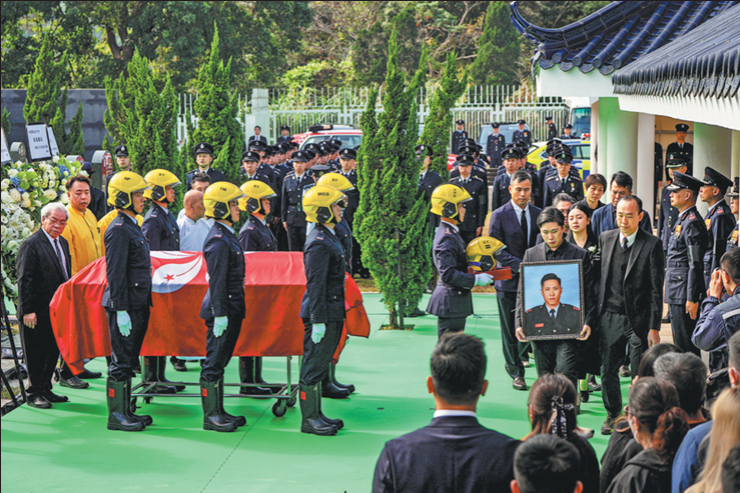Potential seen for regional cooperation
Youths plan to foster development of nations along Lancang-Mekong River
By YANG HAN in Hong Kong | China Daily | Updated: 2024-08-09 09:38

Young Cambodian graduate Uk Sophearith hopes to make a meaningful contribution to the people living in the Lancang-Mekong River region by seizing the opportunities provided by a multilateral framework.
Known as the Lancang-Mekong Cooperation, or LMC, the framework was established in 2016 between China and five Southeast Asian countries along the river.
"For young individuals like myself, close cooperation across the Lancang-Mekong countries offers fascinating potential," Uk, who graduated recently from the Royal University of Phnom Penh, told China Daily.
In July, Uk and his two teammates from China and Vietnam won the Best International Team award for their project, which offers affordable and accessible yoga classes to students to improve their mental health. They won the award at the eighth Youth Innovation Competition on Lancang-Mekong Region's Governance and Development, held at the Phuket Campus of Prince of Songkla University in Thailand.
Lancang-Mekong River refers to the waterway that flows across six countries. Originating from China's Qinghai-Tibet Plateau, it is called Lancang River in China, while further downstream — after flowing out of Southwest China's Yunnan province — it is known as Mekong River, running across Myanmar, Laos, Thailand, Cambodia and Vietnam.
Since the launch of the cooperation mechanism, member countries have been upholding the principle of "shared river and shared future" and jointly promoted the high-quality cooperation of the Belt and Road Initiative, turning it into a "golden model" of regional cooperation.
The resolution adopted by the third plenary session of the 20th Communist Party of China Central Committee on July 18 states that China will continue improving the mechanisms for high-quality cooperation under the BRI.
This includes promoting cooperation in science, technology and innovation, redoubling efforts to develop multilateral platforms for cooperation in green development, the digital economy, disaster mitigation and others, which are expected to elevate LMC regional collaboration.
Referring to the LMC framework, Uk said: "Expanded educational exchange programs may result from increased regional integration, giving me the opportunity to study abroad and acquire a variety of viewpoints."
Cooperation in different industries will also generate new jobs, he added.
"I hope that more Mekong countries can grow like China," said Khun Zaw, founder and CEO of Densilar, a Myanmar-based company in the avocado industry.
Noting that China has become a leader in technology and innovation, Khun Zaw said he hopes to see more cooperation in agricultural technology among the Lancang-Mekong countries, so that the neighbors can learn from China and prosper together.
In July, Khun Zaw participated for the first time in the Lancang-Mekong Youth Entrepreneurs Forum in Kunming, Yunnan. During the gathering, he also met potential business partners from China and Cambodia, and is now preparing for follow-up meetings.
Khun Zaw said the LMC framework provides a good platform for regional young entrepreneurs to know and network with each other.
Working together
Chhay Hongmey, 18, a member of the Youth Empowerment in Climate Action Platform, told China Daily that she is interested in the training programs for youth under the LMC framework because it is important for the region's young people to work together on climate issues.
The platform was established in 2020 by the United Nations Development Programme in Asia-Pacific in collaboration with its partners to engage regional youth in climate action.
Chhay was a speaker at an event on climate adaptation actions and community practice sharing in 2023. The event was held at UNICEF China during the Lancang-Mekong Cooperation Week in April last year.
Chhay, who is working on tackling food waste in Cambodia, said she was inspired by discussions on agroecology and sustainable agriculture at the LMC event.
Having read the Five-Year Plan of Action on Lancang-Mekong Cooperation (2023-2027), Chhay said the framework can make a big contribution to capacity-building, joint research and technical exchange in terms of tackling climate change challenges and facilitating water management across nations.
"I hope the LMC can be turned into a total green project so we can be more sustainable," said Chhay. She added that China's experience, technology and funding will be helpful for the region to implement relevant projects.
Uk, the Cambodian graduate, said young people have the potential to promote the development of the Lancang-Mekong region because their energy, innovation and cultural understanding can position them as catalysts for positive changes.
"In the future, I hope to work across borders to gain significant expertise and knowledge while also contributing to the prosperity of the region."
























